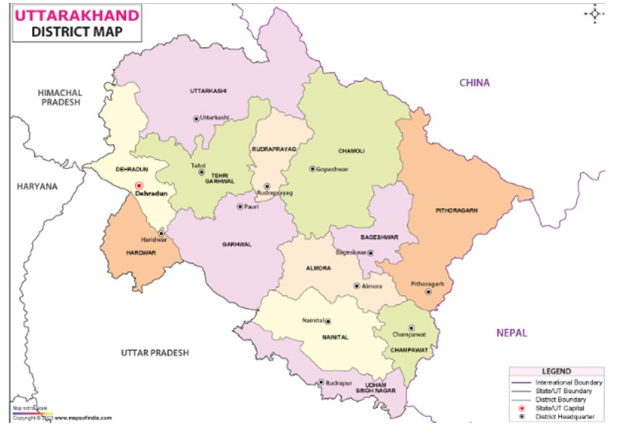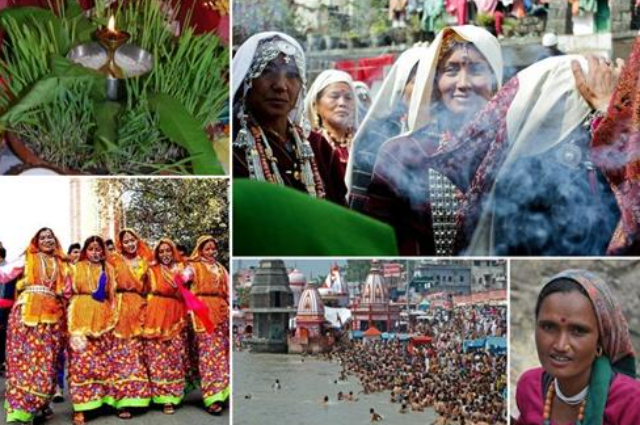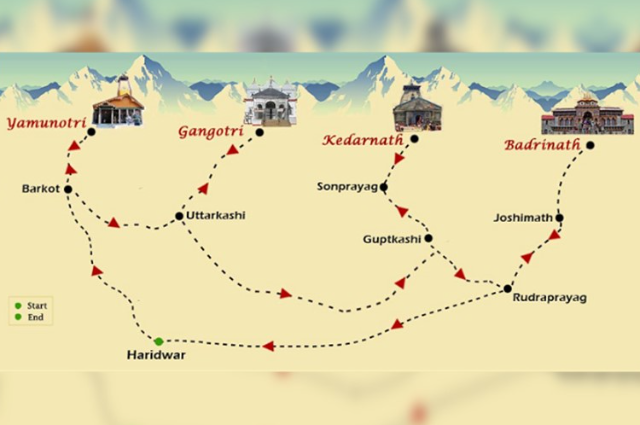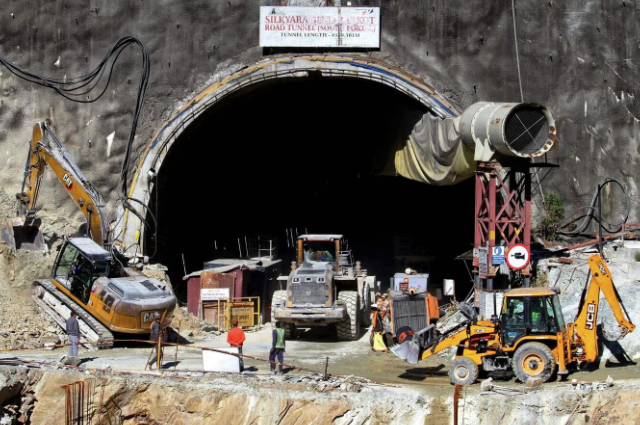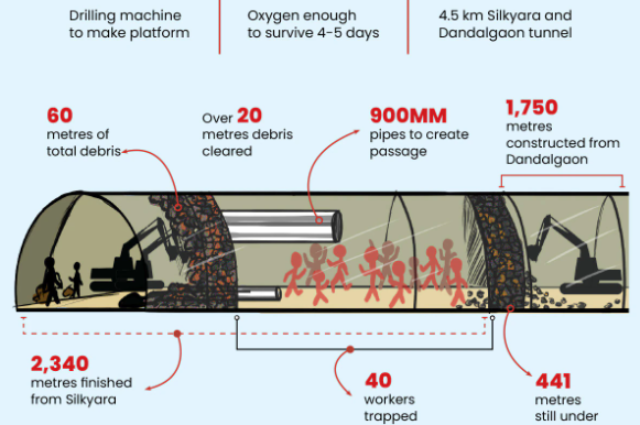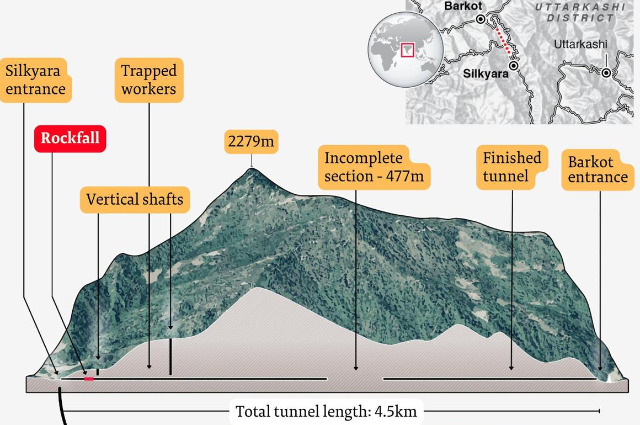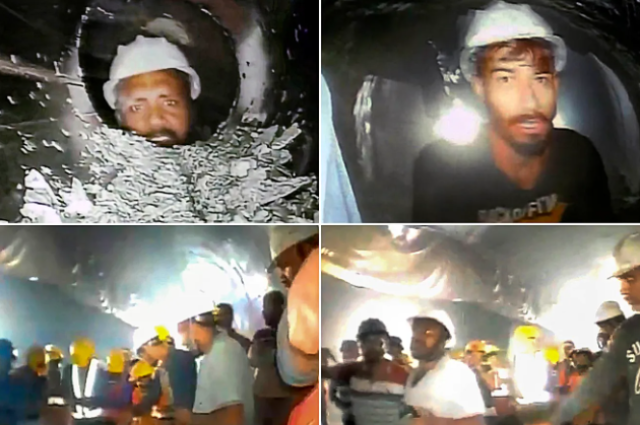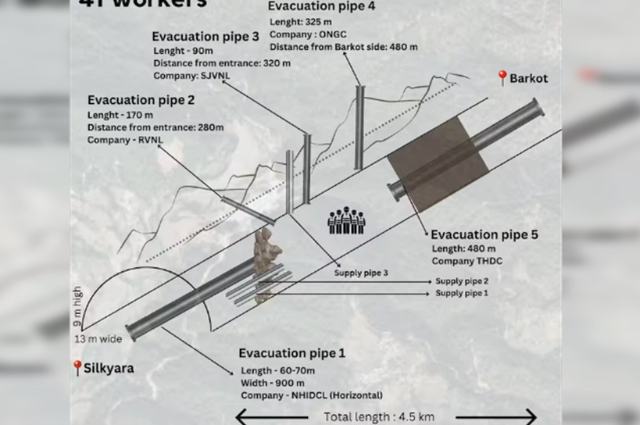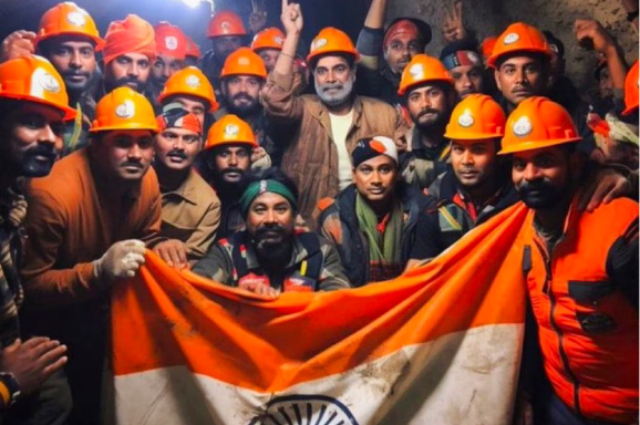"I know, somehow, that only when it is dark enough, can you see the stars" - Martin Luther King
Interpreting Martin’s words, we all come to recognize the strength of humanity and the nurturing spirit of nature in unison. It’s often in our darkest moments that the resilience of the human spirit shines brightest, much like stars against the night sky. Simultaneously, we come to appreciate the nurturing aspect of nature, akin to a mother’s love, which sustains and nourishes us. These two elements, humanity and nature, are intertwined, each revealing its true essence in relation to the other.
The relief of rescue, the joy of survival, expressed only through grateful smiles and tears of joy. This experience, harrowing as it was, became a stark reminder of life's preciousness and humanity's unyielding spirit. It showcased the power of unity, hope, and human will—a miraculous journey that resonated deeply. Illuminating a faint light at the tunnel's end, it taught us the value of daylight, hope's strength, and life's preciousness. Understanding this, we gather the courage to face any challenge, cherishing each moment and never relinquishing hope, even in the darkest depths.
Let's explore...the profound expedition!
BACKGROUND
UTTARAKHAND
Geography:
Uttarakhand is situated in the northern part of India and is bordered by several significant regions:
- Tibet to the North: Uttarakhand shares its northern border with Tibet, the autonomous region of China. This region encompasses the majestic Himalayas, contributing to Uttarakhand's mountainous terrain.
- Nepal to the East: It is bordered by Nepal, a country renowned for its own Himalayan landscapes. This border brings in cultural influences and trade connections.
- Himachal Pradesh and Uttar Pradesh: To the west and south respectively, Uttarakhand shares borders with the Indian states of Himachal Pradesh and Uttar Pradesh. These borders influence cultural exchanges and regional connectivity.
The state's topography includes diverse landscapes, from the towering Himalayan peaks in the north to the plains in the south. This range of altitudes contributes to Uttarakhand's varied climate, ecosystems, and biodiversity.
Natural Beauty:
Uttarakhand is celebrated for its natural beauty, showcasing an array of breathtaking landscapes and tourist destinations:
- Hill Stations: Places like Mussoorie and Ranikhet are popular hill stations offering panoramic views, pleasant weather, and opportunities for trekking and relaxation.
- Pilgrimage Sites: Haridwar and Rishikesh, situated along the Ganges River, are revered as holy cities and attract pilgrims from across the country and the world.
- Scenic Spots: Nainital, known for its serene lake, and Jim Corbett National Park, famous for its wildlife and biodiversity, are among the many scenic spots that captivate visitors.
Religious Significance:
Uttarakhand holds immense religious significance:
- "Devbhoomi": The state is often referred to as "Devbhoomi" due to its association with spirituality and mythology. It's considered the Land of the Gods owing to the numerous temples, shrines, and pilgrimage circuits.
- Char Dham Yatra: The Char Dham Yatra comprises the pilgrimage to Gangotri, Yamunotri, Kedarnath, and Badrinath, considered among the holiest sites in Hinduism. Thousands of pilgrims undertake this spiritual journey annually.
Cultural Heritage:
Uttarakhand boasts a rich cultural heritage:
- Diverse Communities: The state is home to various communities, each with its distinct traditions, languages, cuisines, and clothing styles.
- Vibrant Traditions: The cultural tapestry is woven with vibrant music, dance forms like the famous Garhwali and Kumaoni dances, and colorful festivals celebrated throughout the year.
THE CHALLENGE
The Char Dham Yatra presents various challenges to the pilgrims due to the terrain, weather, and connectivity issues in the region:
Difficult Treks and Challenging Terrains:
- High Altitude Terrain: The pilgrimage routes to Gangotri, Yamunotri, Kedarnath, and Badrinath are characterized by steep ascents, rugged paths, and narrow trails. Pilgrims often encounter rocky terrains and slippery pathways, making the journey physically demanding.
- Remote Locations: Many of these sacred sites are situated in remote and mountainous regions, requiring pilgrims to trek through dense forests, traverse steep slopes, and navigate challenging landscapes.
Unpredictable Weather Conditions:
- Extreme Weather Variations: The yatra season, typically during the summer months, can still experience sudden weather changes in the Himalayas. Pilgrims may encounter sunshine, rain, snow, or hailstorms within a short span of time.
- Temperature Fluctuations: The region experiences drastic temperature changes, especially at higher altitudes. Pilgrims face temperature variations ranging from hot and humid conditions at lower altitudes to freezing temperatures in the upper reaches.
Natural Hazards:
- Landslides and Avalanches: The mountainous terrain is susceptible to landslides and avalanches, particularly during monsoons and in the aftermath of heavy rainfall. This poses risks to the safety of pilgrims traversing through these areas.
- Flash Floods and River Swells: Sudden rains and melting snow can lead to flash floods or cause rivers to swell, making river crossings hazardous for pilgrims.
Limited Connectivity and Infrastructure:
- Inadequate Roads and Infrastructure: The existing roads and pathways to these sacred sites are often narrow, poorly maintained, and lack proper facilities, making travel arduous.
- Limited Medical and Emergency Services: Remote locations often lack immediate access to medical facilities or emergency services in case of accidents or health issues faced by pilgrims.
- Communication Challenges: Limited connectivity in these remote areas makes it challenging for pilgrims to seek assistance or communicate in case of emergencies.
THE SILKYARA TUNNEL PROJECT
The Barkot-Silkyara tunnel project, initiated under the Char Dham Pariyojna (CDP) or All-Weather Road Project, serves as a crucial infrastructural development in Uttarakhand.
OBJECTIVES OF THE PROJECT
Enhanced Connectivity
- Reducing Travel Distance: The primary objective of the tunnel is to significantly reduce the travel distance between the Yamnotri and Gangotri valleys. By shortening the distance from 25.6 kilometers to just 4.5 kilometers, the tunnel aims to provide a more direct and expedited route.
- Improved Access: The tunnel facilitates enhanced accessibility, especially during the Char Dham Yatra, allowing pilgrims to reach the revered sites with ease and reduced travel time. This improved access enhances the overall pilgrimage experience and convenience for devotees.
Safety and Convenience
- Safer Passage: The construction of the tunnel is aimed at providing a safer passage for travelers and pilgrims, circumventing the challenges posed by difficult terrains, unpredictable weather conditions, and the risks associated with the existing roadways.
- All-Weather Connectivity: The tunnel's design caters to ensuring all-weather connectivity, mitigating the disruptions caused by adverse weather conditions prevalent in the region, particularly during the yatra season.
Religious Tourism Promotion
- Catering to Pilgrims: By offering a shorter, safer, and more accessible route, the tunnel directly addresses the needs of pilgrims undertaking the Char Dham Yatra. It supports the surge in religious tourism by providing an improved travel experience for devotees visiting the sacred sites of Yamnotri and Gangotri.
- Enhanced Pilgrimage Experience: The project aims to enhance the overall pilgrimage experience by making the journey more convenient, comfortable, and secure, thereby encouraging more pilgrims to undertake the yatra.
Socio-Economic Development
- Regional Development: Improved connectivity through the tunnel fosters socio-economic growth in the region. It opens avenues for increased economic activities, trade, and tourism-related businesses, benefiting local communities and boosting overall development in Uttarakhand.
- Employment Opportunities: Infrastructure projects like the Barkot-Silkyara tunnel generate employment opportunities, providing jobs during construction and subsequently supporting local livelihoods through increased economic activity.
Infrastructural Advancement
- Modern Infrastructure: The tunnel signifies a leap in modern infrastructure development in Uttarakhand, demonstrating the government's commitment to upgrading transport networks and addressing the region's connectivity challenges.
- Technological Advancements: The project showcases the application of advanced engineering techniques, tunneling methodologies, and safety measures, setting benchmarks for future infrastructure projects in challenging terrains.
TECHNICAL DETAILS
Project Initiation and Cost Allocation:
- Project Initiation: The Ministry of Road Transport & Highways (MoRTH) commenced the project in March 2018, recognizing the need for improved infrastructure and connectivity in Uttarakhand.
- Financial Allocation: An estimated total cost of Rs. 1383 crore was earmarked for the completion of the Barkot-Silkyara tunnel project.
Construction timeline: Construction began in July 2018 with an initial completion target set for July 2022. As of November 2023, about 56 percent of the work is completed. The deadline extended to May 2024 due to ongoing construction progress.
Contract Award and Execution:
- Contractor Selection: National Highways & Infrastructure Development Corporation Limited (NHIDCL) entrusted the Engineering, Procurement, and Construction (EPC) contract to Navyuga Engineering Company Limited (NECL).
- Construction Kick-off: Construction operations commenced in July 2018, with NECL assuming responsibility for executing the project on an Engineering, Procurement, and Construction (EPC) basis.
Length, Location, and Purpose:
- Tunnel Length: The Barkot-Silkyara tunnel spans a length of 4.5 kilometers, making it a significant infrastructure development in the Uttarkashi district of Uttarakhand.
- Geographical Location: Situated in the northern reaches of Uttarakhand, the tunnel aligns close to National Highway 134, connecting the Barkot and Silkyara regions.
- Primary Objective: The primary intent behind the construction of the tunnel is to offer a shorter, safer, and more accessible passage between the Yamnotri and Gangotri valleys, specifically designed to cater to the influx of pilgrims during the revered Char Dham Yatra.
Tunnel Alignment and Reduction of Travel Distance:
- Strategic Alignment: The tunnel's design incorporates an alignment that passes beneath the Radi pass, strategically aimed to reduce the travel distance between the Yamnotri and Gangotri valleys.
- Distance Reduction: By significantly shortening the travel distance from 25.6 kilometers to just 4.5 kilometers, the tunnel facilitates a remarkable reduction in travel time and offers a more convenient route for pilgrims visiting the sacred sites during the Char Dham Yatra.
Tunnel Design and Construction:
- Tunnel Type: The Barkot-Silkyara tunnel is a two-lane bidirectional tunnel designed to accommodate vehicular traffic.
- Tunnel Boring Method: The construction might involve the use of Tunnel Boring Machines (TBMs) or conventional drilling and blasting methods, depending on geological conditions.
- Support Systems: Installation of rock bolts, shotcrete, steel arches, and other support systems ensures tunnel stability and prevents rockfall or collapses.
Geotechnical Challenges and Solutions:
- Rock Composition: The region's geology includes various rock types—schist, gneiss, granite, and sedimentary formations—each posing different challenges during excavation.
- Tunneling Techniques: Engineers employ specialized methods like the NATM or Sequential Excavation Method (SEM) to adapt to varying geological conditions.
- Groundwater Management: Dewatering and groundwater control measures are crucial to prevent water ingress during excavation.
Ventilation and Safety Systems:
- Ventilation Design: The tunnel's ventilation system includes axial fans, jet fans, and longitudinal ventilation ducts to ensure proper airflow and maintain air quality within the tunnel.
- Emergency Systems: Installation of emergency evacuation passages, fire detection systems, and firefighting equipment ensures safety in case of emergencies.
Electrical and Lighting Systems:
- Lighting Arrangements: High-efficiency LED lighting along the tunnel length provides adequate visibility for drivers and ensures safety within the tunnel.
- Power Supply: Reliable power supply systems, including backup generators, are essential for uninterrupted tunnel operations.
Monitoring and Control Systems:
- Integrated Control Center: Implementation of a centralized control room equipped with advanced monitoring systems for traffic, ventilation, fire detection, and CCTV surveillance.
- Traffic Management: Installation of intelligent traffic management systems, including speed monitoring and variable message signs, to regulate traffic flow and ensure safety.
TUNNEL COLLAPSE - THE DISASTER
Disaster Strikes on November 12, 2023:
At approximately 05:30 am on November 12, 2023, Diwali morning, a catastrophe unfolded within the depths of the tunnel as workers engaged in reprofiling work between the 260 to 265-meter mark faced a sudden collapse of a 55-meter section spanning from 205 to 260 meters. The incomplete section on the opposite end left no avenue for escape.
A Mechanic's Account:
Shashi Chauhan, an NHIDCL mechanic, recounted in a video interview with The Indian Express that over 40 workers were actively engaged in the tunnel's night shift. The imminent conclusion of their shift around 08:00 am was abruptly disrupted by the incident. While some workers managed to exit, approximately 40 remained trapped inside. Chauhan reassured that the workers were safe, maintaining communication via walky-talky, occupying a space of around 400 meters, and receiving essential supplies of oxygen, water, and food.
*But 41 workers were trapped inside.
From Slow Fall to Sudden Blockade:
The report detailed the gradual descent of debris initially, an occurrence that wasn't immediately perceived as a significant threat. However, the situation rapidly escalated, resulting in the complete blockage of the tunnel. Amidst this chaos, only a handful—approximately 3 to 4 workers—could evade the disaster, leaving the rest entrapped. Another witness, sharing insights into the incident, highlighted the regular engagement of 65-70 workers across two shifts, spanning 12 hours each, involving multiple construction companies including NECl, Sri Sai Construction, Nav Durga, and PB Chaddha.
Why did this happen?
The incident remains shrouded in mystery as official statements on the underlying causes are yet to emerge. Various media sources, however, have illuminated several perspectives shared by experts, shedding light on plausible factors contributing to the tragic event.
- Geological Pressures: Dr. Ranjit Kumar Sinha, Uttarakhand's Disaster Management Secretary, attributed the collapse to the pressure exerted by loose rock materials above the affected tunnel section. Despite initial installation efforts, the presence of soft rocks and loose materials led to the calamitous collapse. Sinha emphasized the ongoing priority of rescuing trapped individuals before addressing the affected area.
- Surveys and Project Oversight: Geologist Naveen Juyal, highlighted in the Down To Earth report, raised concerns about the tunnel's location in close proximity to the earthquake-prone Main Central Thrust (MCT) area. Juyal emphasized the importance of a meticulous investigation into the project's Detailed Project Report (DPR), questioning the project's readiness in the face of seismic geological factors.
- Rush Versus Precaution: Scientist Ravi Chopra, a former chair of a committee monitoring project violations, emphasized the necessity of extensive geological surveys before project initiation. However, he lamented the rush to complete projects swiftly and inexpensively, often sacrificing necessary surveys. Chopra connected incidents like the Silkyara collapse to this haste.
- Geological Vulnerabilities: Reports from The Times of India echoed concerns, citing the construction site's composition of lime rock, susceptible to frequent collapses. Geologist SP Sati outlined potential reasons, suggesting the presence of an unreported blind shear zone and potential issues related to the use of explosives during tunneling. Sati, in a debate program, hinted at compromised safety protocols during the tunnel's construction.
- Conflicting Narratives: Contradictory reports emerged as ANI highlighted specific actions taken before the incident according to NHIDCL. However, NHIDCL officials denied the existence of such a detailed report, leading to confusion. Anshu Manish Khalko, NHIDCL's Director of Administration and finance, underscored the challenging terrain's fragility, attributing recurring collapses to the environment's complexities.
The incident's true causation remains elusive amidst these varying viewpoints, underscoring the imperative need for a thorough investigation into the circumstances surrounding the tunnel collapse.
Timeline of the events happened:
Nov 12, 2023: As the sun dipped behind the hills of Uttarakhand, the serene construction site of the Silkyara tunnel turned chaotic. A thunderous landslide trapped forty-one workers inside the tunnel, prompting an urgent rescue operation.
November 13, 2023 - Multiple agencies, including NDRF, SDRF, BRO, NHIDCL, and ITBP, initiate rescue efforts. Air-compressed pipes are employed to provide trapped workers with essential supplies like oxygen and food. Contact is established, assuring the workers' safety, although ongoing falling rubble increases the debris area within the tunnel.
November 14, 2023 - Despite efforts to insert steel pipes for horizontal digging, additional rubble falling from the cave-in causes minor injuries to two laborers. A new drilling machine is requested to expedite operations.
November 15, 2023 - A state-of-the-art auger machine is airlifted from Delhi to accelerate the rescue operation. Assembly and installation of the machine begin, commencing operation past midnight.
November 16, 2023 - The newly acquired drilling machine starts working, making progress through the rubble, but the process is halted when the fifth pipe encounters an obstacle.
November 17, 2023 - Significant progress is made as the machine drills about 24 meters through the debris. However, the operation comes to a sudden stop when concerns arise about potential further collapse within the tunnel vicinity.
November 18, 2023 - Drilling operations remain suspended due to fears that vibrations from the machine might trigger more debris collapse, posing risks to rescue personnel. Alternative evacuation plans, including vertical drilling, are explored by experts.
November 19, 2023 - Despite discussions about the best course of action, horizontal drilling remains the favored method. Union Minister Nitin Gadkari emphasizes the potential of boring horizontally with the auger machine.
November 20, 2023 - Prime Minister Narendra Modi enquires about the ongoing operations. However, horizontal drilling remains suspended due to an obstacle blocking the progress of the machine.
November 21, 2023 - A video of trapped workers receiving food through a pipeline is released. Efforts begin to drill another tunnel as an alternative, although the process is estimated to take up to 40 days. Horizontal boring operations resume overnight.
November 22, 2023 - Horizontal drilling progresses to about 45 meters, with roughly 12 meters remaining of the 57-meter debris stretch. Ambulances stand by for potential rescue efforts, but an obstacle obstructs the auger machine's path.
November 23, 2023 - After a six-hour delay caused by an obstruction, drilling progresses to the 48-meter point. However, concerns arise as cracks appear in the platform supporting the drilling machine, leading to another halt in operations.
November 24, 2023 - Resuming drilling efforts encounter further hurdles when the machine hits a metal girder, delaying progress yet again.
November 25, 2023 - The auger machine blades become stuck in the debris, prompting officials to consider alternative options that could potentially extend the rescue timeline by days or even weeks. Manual drilling or drilling from above are among the options considered.
November 26, 2023 - Vertical drilling of 19.2 meters begins to create an alternative escape route. Simultaneously, efforts are made to insert 700-mm wide pipes for an escape passage.
November 27, 2023 - Experts in rat-hole mining join the rescue, focusing on horizontal digging through around 10 meters of rubble. Meanwhile, vertical drilling from above reaches a depth of 36 meters.
November 28, 2023 - Rat-hole mining experts break through the last stretch of rubble around 7 pm. NDRF and SDRF personnel enter the steel chute, successfully evacuating all 41 trapped workers using wheeled stretchers, bringing an end to the challenging rescue mission.
DRILLING METHODS CARRIED
Vertical Drilling:
Vertical drilling involves boring directly downward from the ground's surface using specialized machinery and electrical tools. In the Uttarakhand tunnel collapse rescue, a vertical drill was utilized to create a shaft, into which an 800-mm pipe was inserted to reach and extract the trapped workers. This method allowed for a direct vertical access point to the trapped area.
The vertical drilling phase has been completed, and the remaining soil and debris will be cleared through manual drilling techniques.
Auger Mining (Horizontal Drilling):
Auger mining employs specialized tools such as horizontal auger machines or directional drills to create horizontal bores or tunnels underground without disrupting the surface. These machines are typically used for laying pipes for water and gas distribution, as well as tunnel excavation.
However, in the Uttarakhand tunnel collapse rescue, the auger machine faced setbacks, encountering metal obstructions that led to its breakdown beyond repair. Despite its intended purpose, the machine failed to free the trapped workers due to these obstacles.
Significant progress has been made in the rescue operations with the completion of over 51 meters of drilling using the vertical machine, leaving approximately 56 meters to be excavated. Following this, the plan involves airlifting the trapped workers out through buckets, marking a crucial phase in the ongoing rescue efforts.
Rat Hole Mining:
On Tuesday, November 26, 2023, rescue teams diligently drilled through a 60-meter expanse of debris within the collapsed tunnel. The National Disaster Response Force (NDRF) personnel were poised to enter the steel chute that had been meticulously inserted into the drilled passage over the preceding days, readying themselves to bring the workers to safety, one by one. The practiced procedure entailed each worker being positioned on a wheeled stretcher, gently maneuvered outside by the rescue team using ropes—a process estimated to take approximately two to three hours. Following multiple setbacks due to the breakdown of the imported auger machine, the final stage of the rescue mission was triumphantly achieved by "rat miners." These skilled individuals successfully completed the drilling process, clearing all debris, thereby paving the way for the laying of pipelines and the long-awaited liberation of the trapped workers from the collapsed tunnel.
How Rat-Miners Executed the Rescue
A trio of rat-miners orchestrated a meticulous rescue operation within the debris-filled pipe. Operating in shifts, one dug through the rubble, another loaded debris into a trolley, while the third managed the trolley's movement along a shaft. They averaged a rate of 0.9 meters per hour and rotated in fresh teams hourly. By 3 pm the next day, they had excavated 12-13 meters, comprising a team of 12 rat-miners from Uttar Pradesh and Madhya Pradesh.
Extraction Technique
Once drilling was completed, wide pipes were maneuvered through the debris to construct a tunnel. National Disaster Response Force (NDRF) teams, equipped with oxygen kits and wheel-fitted stretchers, navigated through the pipes. Following them, medical personnel assessed the trapped workers' conditions and guided them on navigating the pipe tunnel. Workers were then systematically brought out on stretchers secured with ropes, with NDRF personnel exiting last, culminating in a three-hour operation.
Supplying Essentials
Initially, food reached the trapped individuals through a 4-inch pipe via compressed air. Later, a larger six-inch pipe facilitated the transport of solid food items such as chapati, vegetables, and fruits for improved nutrition. Cylindrical bottles and a specially designed tray attached to a rope were employed to deliver these essentials.
Augur Machine's Role in Final Rescue
The pivotal augur machine, housing a helical screw-like blade, drilled for 55 meters before breaking. The American Auger 600-1200, known for high-powered horizontal drilling, was utilized. It boasts the capability to create holes ranging from 5-10 feet in diameter. The machine not only drills but also removes excavated material through its design, utilizing the spiral flights of the auger to lift debris as it rotates. The machine took an hour to drill a meter and necessitated 4-5 hours to install pipes. Using the auger, 900 mm and 800 mm pipes, each six feet long, were inserted and welded to form a tunnel.
Understanding Rat Hole Mining
The term "rat hole" denotes these minuscule pits, tailored for single-person access, usually navigated using ropes and bamboo ladders. However, due to its inherent dangers, the practice is considered highly hazardous, leading to instances of asphyxiation, oxygen deprivation, and hunger-induced fatalities, resulting in its prohibition across many countries. An alternative form involves creating rectangular openings, leading to vertically dug pits of considerable depth, followed by the extraction of coal through rat-hole-sized tunnels.
The Ban and its Justification:
Criticism of rat mining stems from its perilous working conditions, environmental harm, and numerous accidents resulting in injuries and fatalities. Experts contend that these mines operate with minimal regulation, lacking fundamental safety measures like proper ventilation, structural support, or safety gear for workers, posing grave risks to those involved. Furthermore, the mining process contributes to land degradation, deforestation, and water pollution, prompting the National Green Tribunal (NGT) to impose a ban in 2014, citing numerous incidents of fatalities due to flooding during the rainy season caused by rat-hole mining. The NGT emphasized the perilous nature of the practice, with instances of fatal inundations in mining areas, ultimately upholding the ban in 2015 as a measure to protect lives and the environment.
GRATITUDE AND APPRECIATION
A resounding applause and heartfelt gratitude to the reporters who tirelessly worked to keep us informed, providing updates and insights throughout this trying period. Your dedication in bringing forth the latest developments in the rescue mission has been invaluable, keeping us connected and hopeful.
To the unwavering rescue teams who displayed unparalleled courage and unwavering commitment in the face of adversity, your tireless efforts have been nothing short of heroic. Your selflessness, determination, and round-the-clock endeavors are a beacon of hope and inspiration for all of us.
A special acknowledgment to the families enduring this arduous wait, displaying remarkable patience, resilience, and unwavering faith during these challenging times. Your unwavering support and strength have been a pillar of encouragement for those trapped and for everyone involved in the rescue operation.
And to the trapped workers themselves, your endurance, resilience, and unwavering hope in the face of adversity have been nothing short of commendable. Your perseverance and faith amidst this ordeal are a testament to human strength and solidarity.
Together, each one of you has shown extraordinary strength, unity, and determination in this challenging chapter. Your collective efforts and unwavering spirit embody the true essence of solidarity and hope. Let us continue to stand together, supporting one another as we navigate through this testing phase.
LESSONS LEARNED
In the heart of the Uttarakhand tunnel collapse, a mosaic of diversity unfolded - 41 workers, each hailing from different corners of the nation, converged in fate's embrace. Alongside them stood a rescue force, an amalgamation of varied states and backgrounds, united by a singular purpose: to save lives and uphold the banner of humanity.
Amidst this tableau, doctors, drawn from diverse castes, states, and religions, knelt in service, transcending differences to weave a tapestry of care and compassion. Despite their varied origins, their unified mission resonated in harmony - to heal, to mend, to honor the sanctity of life.
This confluence of souls from different walks of life, bound by a shared commitment to humanity, paints a portrait of solidarity. It stands as a poignant reminder that beyond the labels that distinguish us, lies an unspoken kinship rooted in our collective yearning for empathy, compassion, and a shared sense of responsibility towards our fellow beings.
"In the silent eloquence of tears, a mother's smile speaks volumes, embodying life's most profound and cherished moments."
Conclusion:
Amidst the darkness of a collapsed tunnel, a story of resilience and unity unfolded, transcending boundaries of caste, creed, and geography. For 41 workers from diverse corners of the nation, trapped in the silence of adversity, hope flickered amidst the daunting uncertainty. Across this desolate space, a symphony of rescue efforts echoed, harmonized by a diverse ensemble of courageous souls - a multi-state rescue team, doctors hailing from varied castes, states, and religions. Their collective mission was clear: to rescue, to heal, and to uphold the essence of humanity. In this dire chapter, they showcased the unwavering strength that resides within unity, empathy, and a shared determination to embrace the sanctity of life. As they emerged from the depths, their faces etched with the trauma endured, they carried with them a testament to the unspoken bond of shared empathy, a poignant reminder of the power of unity in the face of adversity. This story is not merely about survival; it's an ode to the enduring spirit of humanity, a beacon guiding us to unite, to empathize, and to cherish the resilience that shines brightest in our darkest hours.
. . .
References:
- https://www.bbc.com/news
- https://www.wionews.com/india-news
- https://www.ndtv.com/india-news
- https://www.thehindu.com/news/national
- https://www.greaterkashmir.com/latest-news/
- https://www.theweek.in/news/biz-tech/
- https://indianexpress.com/article/india
- https://apnews.com/article/
- https://thewire.in/business/
- https://www.indiatoday.in/environment/
- https://economictimes.indiatimes.com/news/
- https://fvbb.com/ns/
- https://timesofindia.indiatimes.com/city
- https://www.cnbctv18.com/india
- https://www.hindustantimes.com/india-news


